Gem Virtuosos: The Drehers and Their Extraordinary Carvings
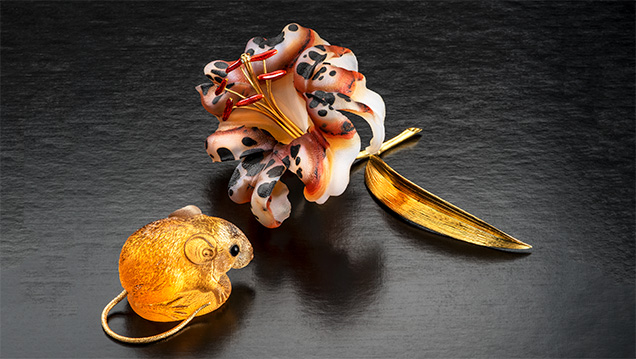
ABSTRACT
The German towns of Idar and Oberstein (now Idar-Oberstein) have a rich history of gem cutting and carving, notably in agate. The profession continues to be passed on from one generation to the next, as it has been for over five centuries. One of these families, the Drehers, has worked with gem materials for 13 generations. Gerd Dreher apprenticed gem carving with his father starting in 1955, while Gerd’s son, Patrick, began his apprenticeship in 1988. While they carve individually, occasionally they work together as a team. The family creates fine carvings from agates and from single crystals of high-quality rough gem minerals. These unique pieces are extraordinarily detailed and utilize natural color zoning to achieve a remarkably lifelike effect.
INTRODUCTION
Viewed from any direction, the gem carvings by the father-and-son team of Gerd and Patrick Dreher are remarkably lifelike. Agate toads appear bumpy, glistening, and slippery. Brimming with personality, their eyes appear to follow the viewer around the room. A carved tiger lily emerges from banded agate (figure 1) as a velvety, dappled flower, its petals enticingly curling inward. And on the backs of these petals, details of the flower’s physiognomy are scrupulously maintained. Much like the gem materials from which they are carved, these works are one-of-a-kind creations.
Decades of experience between the two imparts virtuosity to their work, as well as a sense of humor often depicted in the subjects. Today, Gerd is globally acknowledged as a master of the craft, while Patrick has emerged from the younger generation, adding new carving techniques to the family repertoire. This enhances the formidable range of skills that have been passed down through the Dreher family for 13 generations.
Following in the path of their ancestors, the Drehers’ ability to render the anatomy of flora and fauna in astonishing detail demands an intimate knowledge of their subject matter, not to mention a deep understanding of the characteristics and attributes of the gem materials they carve. The Drehers study rough gem material, sometimes for years. From these observations they conceive a three-dimensional outcome and then set to work bringing the stone to life (figure 2). A growing collection of diamond-sintered tools, and a thorough understanding of how to use them, underpins their closely guarded lapidary techniques.
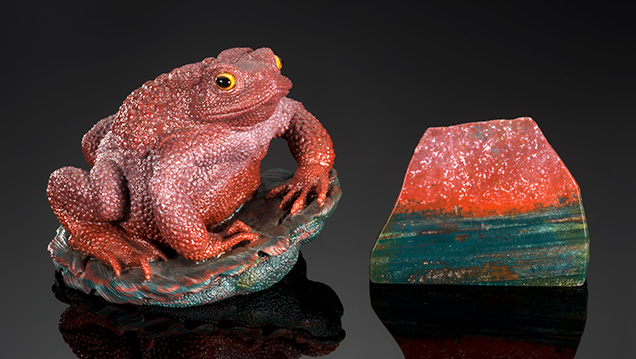
IDAR-OBERSTEIN’S GEM INDUSTRY
An understanding of the environment that gave rise to the Dreher dynasty—as well as hundreds of other celebrated practitioners of the lapidary arts—is essential to appreciating their story. Idar and Oberstein (figure 3), two picturesque German towns separated by the Nahe River in the state of Rhineland-Palatinate, were united in 1933 to form Idar-Oberstein.
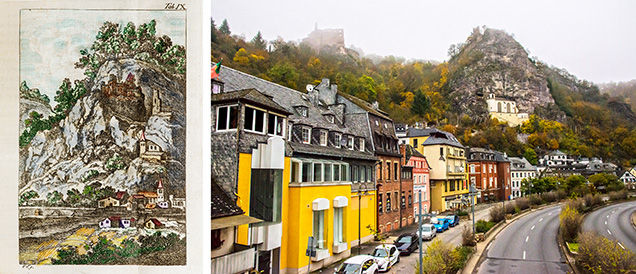
This area in southwestern Germany, nestled in the Hunsrück mountain range, became famous for its agate and quartz deposits, as well as its residents’ expertise in gem-related professions such as mining and cutting and more recently goldsmithing. Idar lore suggests that agate nodules and quartzes, such as chalcedony, jasper, carnelian, and petrified wood, were discovered by farmers as they plowed their fields centuries ago (figure 4). Agate mining and cutting flourished there for at least five hundred years.
Some believe the Romans who conquered the region used Idar’s agates more than two thousand years ago. A cameo found at Hidera, a Roman settlement in the mountains above present-day Idar, suggests this ancient glyptic use of its agates (Rapp, 2002). Other scholars dispute the Roman connection, but there is agreement that the deposits were mined during the Middle Ages. Cutters worked with gem materials from the area, and by the fourteenth century the region’s agate cutting industry was established (Ball, 1931). Traditionally, the gem cutting trade has been centered in Idar, with jewelry manufacturing and related professions evolving in neighboring Oberstein and other hamlets (Frazier, 1978).
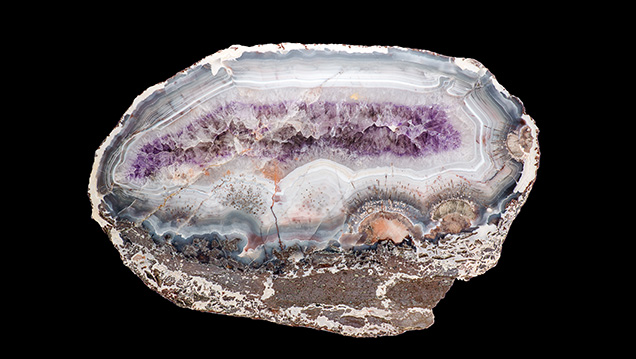
In the early days of the agate cutting industry in Idar, water from nearby rivers—the Nahe, the Idarbach, and others—provided energy used to turn massive sandstone wheels for cutting (Frazier, 1978). Large wheels, up to three meters in diameter, were used to shape the agate’s exterior. Cutters from the area developed a technique in which they lay stomach-down on a wooden bench. This position, with their feet pressed against the floor, or against a block of wood nailed to the floor, gave them the necessary leverage to push the gem material against the rotating wheel and cut it (figure 5). The first record of a water mill used to grind stone was in 1454 (Gerdt, 2017). A Grinder’s Guild document dating back to 1609 bears witness to the profession, including strong advice to its members: “No stranger must acquire the trade of a grinder, but the craft must be handed down from father to son” (Hadley, 1984).
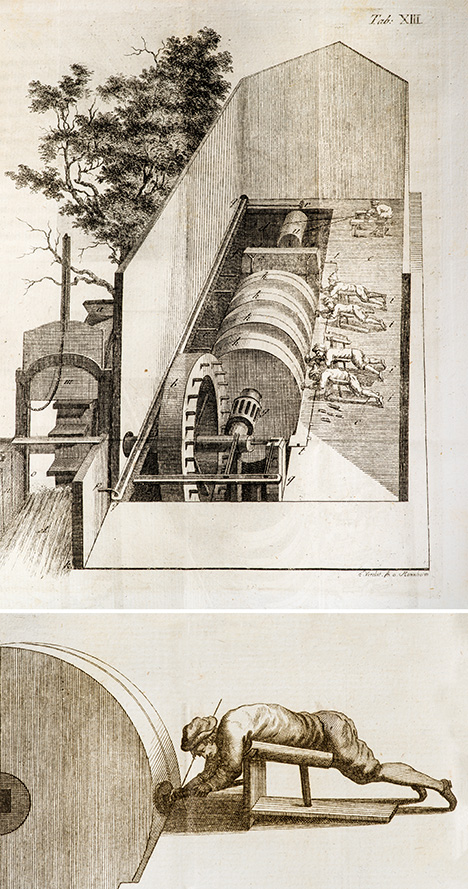
It was long, difficult work that demanded physical strength. Smaller wheels were used to refine the interior—to hollow out preform bowls, for example. Accounts passed down through the Dreher family note that agate cutters rose at 4:00 a.m. and went to the water mills in Vollmersbach to await their turn at the wheel. Much of the work had to be done around farming obligations since cutting alone could not support the tradesmen. Throughout the small artisan workshops of Idar, family secrets learned at the cutting wheel were passed down through generations. Gem carving techniques and individual styles evolved with specific creative refinements and specialties that in many cases could be attributed to different carvers or their families (Dreher, 1979).
Gem cutters later developed foot-powered devices to cut the agates, which was followed by the advent of electric-powered engines to turn the spindles. These refinements allowed cutters to sit upright rather than lying on their stomachs. One technique did not change: While in many other parts of the world the gem material is held stationary and the craftsman moves a flexible tool around it to form the desired shape, Idar’s cutters have always held the gem rough, as steadily as they can, in two hands. This practice continues today. The gem is moved around a fixed spindle, progressively grinding down the material. A wide variety of diamond tools are mounted on these spindles, depending on the effect that is needed, and the speed can range from 3,000 to 11,000 revolutions per minute (rpm). According to Patrick Dreher, both the spindles and the diamond tools are manufactured in Idar-Oberstein to each cutter’s specifications. Gradually, the process reveals the carver’s vision (figure 6).
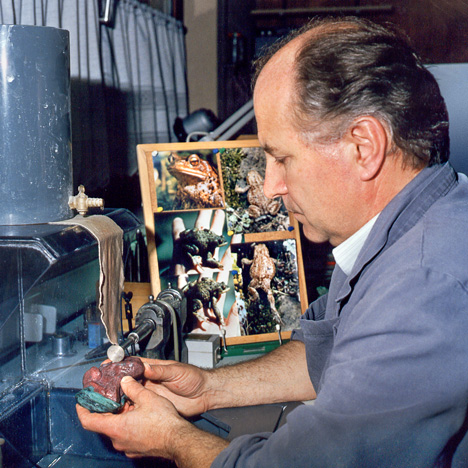
A dramatic change in the supply of agate and quartz occurred in the early nineteenth century. The Hunsrück deposit was nearing depletion following centuries of exploitation. The resulting decline in centuries-old mining traditions could have spelled the end of Idar’s cutting trade. Fortunately, between the 1820s and 1850s, German explorers and farmers homesteading in southern Brazil found new and vastly richer sources for agate and quartz along the border with Uruguay. The agate and quartz were discovered the same way they had been in Idar centuries before: by plowing the fields. Starting in 1825, shipments of the rough gem material made their way to Idar. The quantity and quality of the Brazilian agate surpassed anything that had been known from the Hunsrück deposit. According to a Scientific American report from the time, up to 300 tons of agate were shipped each year to Idar and Oberstein, where some 6,000 people were employed in the trade (“Where agates come from,” 1882). Other Brazilian gems such as quartz, tourmaline, topaz, and beryl were eventually imported, greatly expanding the town’s offerings. The variety and availability of gem materials brought new opportunities and challenges for the cutting center.
Germany exported much of its new material to French artists in the mid-1800s, during the waning days of Romanticism. Paris was a magnet for artists of all disciplines, including fine art stonecutters and gem engravers. The new Brazilian agate spurred a revival of gem engraving and carving, enabling cutters to create cameos, intaglios, and seals using its multicolored layers for relief (Lindemann, 2017).
Young craftsmen from Idar began flocking to Paris, learning refined engraving and cameo carving techniques from Parisian masters. The start of the Franco-Prussian War in 1870, however, hastened the Germans’ return to their native land. These artists, who now had abundant raw imported material at home, were soon able to surpass the skills they had learned in France. With the sudden influx of skilled carvers, Idar’s renaissance as a gem center was well on its way. Many artists formed engravers’ guilds upon their return, with more than 230 members in Idar and Oberstein (Pauly, 2012). The guilds helped train apprentices and enabled members to hone their cutting and carving skills. They also established a stable pricing structure for products. These developments cemented Idar-Oberstein’s modern role as a center for agate cutting and engraving. The new skills acquired in Paris also prepared the cutters for the development of three-dimensional carving.
THE DREHER DYNASTY
Accounts suggest that one of the most admired cutters and engravers in nearby Vollmersbach during the late 1800s was Wilhelm Dreher (1840–1900). His meticulous work was widely commissioned both in Germany and internationally. An agate bowl of Wilhelm’s, weighing 43 kilograms, was sent to French emperor Napoleon III (Dreher, 1979). Other items were sent to British royalty. One of Wilhelm’s sons, possibly Karl (1861–1943), produced a lapis lazuli bowl for Emperor Nicholas II of Russia in the early 1900s. While the whereabouts of the bowl are unknown today, its sale was documented in the Dreher family history (Dreher, 1979). Karl Dreher’s work, and that of other German artists at the time, marked the beginning of Idar’s three-dimensional gem-carving tradition.
The Dreher lineage has been traced back to 1620, but the family believes their ancestors began working with gems from the region much earlier. Some details were recorded in birth, marriage, and death certificates. Dreher activities were also gleaned from property ownership records, particularly with regard to lapidary mills the family bought, owned, or sold over time.
Unfortunately, many Idar and Oberstein records before 1620 were destroyed during the Thirty Years’ War (1618–1648), a religious conflict in central Europe. This period witnessed considerable devastation of churches and the loss of parish records. Destruction of records was repeated in both World Wars, leading to ambiguities about the provenance of some important unsigned works of art, where the craftsmen cannot be verified with certainty. This was true for the Drehers and many other notable agate cutting families in Idar.
Wilhelm’s son Karl was the first in the modern line of Drehers (figure 7) who developed skills as gemstone carvers, instead of simply cutters. As a young man he trained under a master carver who had returned from Paris, learning how to carve cameos, monograms, and other ornaments. These skills greatly expanded the Drehers’ repertoire as they began to add engraving and carving to their skills. With the increased exposure to international carving styles and art movements, the family’s worldview began to expand as well.
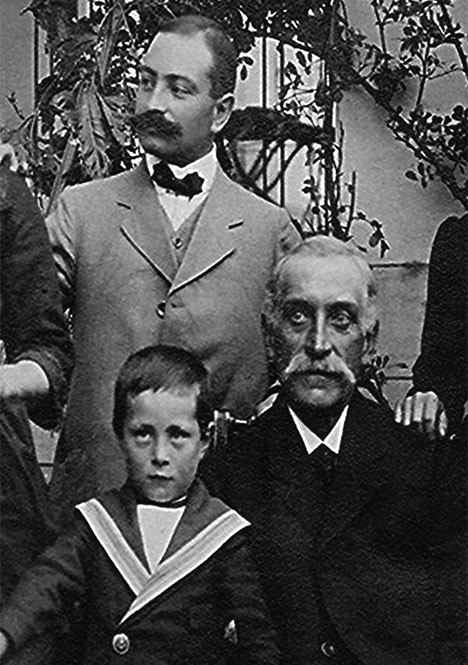
Meanwhile, Karl Wild, a contemporary of Karl Dreher who was related to the Dreher family, saw opportunities outside of Idar and traveled to Russia, acquiring the nickname “Russ-Karl.” There he not only sold finished carvings and objects of art by Karl Dreher and others from Idar but also took orders and brought back raw materials (such as Russian lapis lazuli) to be carved. The lapis lazuli bowl mentioned earlier is one such piece.
THE DREHERS DURING THE ERA OF FABERGÉ
The Dreher family, like many others in Idar, relied primarily on a series of brokers to sell their work. One notable gem dealer was Moritz Stern, who brought specific orders to Idar from abroad. These orders were placed with the town’s best carvers. Among those who recognized Idar’s lapidary talent, and who would soon use Stern’s services, was Carl Fabergé, who developed an appreciation for hardstone cutting while traveling through Florence, Dresden, and Idar in the late 1880s (von Habsburg, 1988). Fabergé was also influenced by Japanese netsuke1 carvings, amassing a collection of some 500 pieces. These were popular items from sixteenth-century Japanese clothing.
As a result of these influences, lapidary orders coming into Idar at the turn of the twentieth century included specific requests from Fabergé in St. Petersburg. Fabergé developed small plaster models of animals, which were supplied to the gem cutters and replicated in stone (Adams, 1988). These works were either assembled pieces or objects made from a single piece of stone. After the finished pieces were returned to Fabergé, his workmasters would apply embellishments such as gold legs and feet (Wild, 1981). Patrick Dreher credits these Fabergé orders with changing the family’s focus from the simple cutting of agates toward carving in more artistic forms. Karl Dreher’s son, Hermann (1886–1960), is one of the artists who provided carvings purchased by Fabergé. The Drehers say these works were faithfully carved from plaster models provided by Fabergé craftsmen (figure 8, left; Ovchinnikov, 2017). Although these models were considered worthless after the hardstone work was done (figure 8, right), and most were lost to time and history, the family managed to keep one such model.
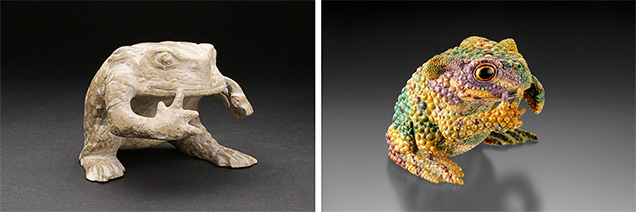
This period marks the earliest shift to three-dimensional gem carvings. The Dreher family maintains only two such early carvings in its possession: the rock crystal bowl seen in figure 9, and the figure of a gem carver with a bowl in figure 10.
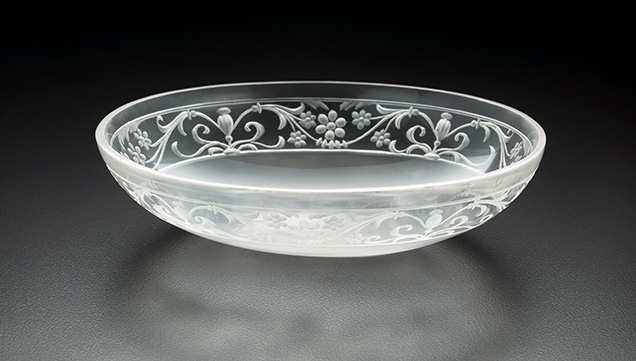
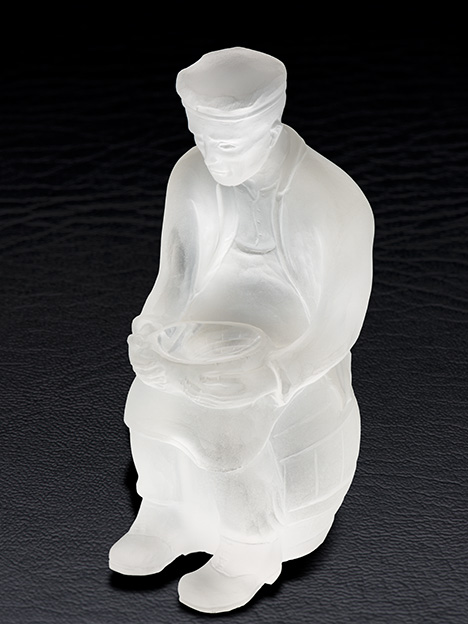
Even with family members brokering some of the business, the hardstone carvings went unsigned and were subsumed under the Fabergé name. The venerable Russian firm relied to some extent on outside vendors for a variety of goods they could not manufacture themselves. The items supplied had to be of the highest caliber and craftsmanship, reflecting expertise simply not found in Russia at the time.
German lapidary craft is acknowledged in the Fabergé literature. References indicate that the first carved hardstone animals likely came from Idar. In Fabergé, Dr. Géza von Habsburg writes: “Fabergé took up the search for hardstone carving outside of Russia… [H]is journey led him to Idar-Oberstein, a little town specialized in the cutting and engraving of Brazilian agate.” Von Habsburg singles out the German carver Alfred Heine, working for the Wolff Company, who “produced stone animals for Fabergé.” He goes on to say that “Fabergé’s numerous commissions brought about a new flowering for the old stone cutting center” (von Habsburg, 1988). This is also acknowledged by Russian experts. “It is a well-known fact that the Idar-Oberstein masters made large quantities of carvings for Fabergé,” said Galina Gabriel, a member of the International Association of Art Critics and the Russian Union of Artists who spoke at the 2015 International Fabergé Conference in St. Petersburg.
After 1908, Fabergé acquired the Woerffel factory in St. Petersburg to handle the firm’s lapidary needs. Orders for the carved animals, commissioned through Fabergé and originally carved in Idar, consequently slowed in Germany. After World War I (1914–1918), such carvings came to an abrupt halt. Widespread social unrest in Russia culminated in the 1917 Russian Revolution and the execution of Emperor Nicholas II and his family in July 1918. Fabergé lost all of its wealthy Russian patrons. The firm was nationalized, closing its doors in November 1918 (Snowman, 1962; Faber, 2008). The destruction of records in both Germany and Russia left a gap in the full understanding of Idar carvers’ links to Fabergé. Nonetheless, the seeds had been sown for the growth of some of the world’s greatest three-dimensional gem carvers.
MASTER CARVERS: FROM FATHER TO SON
Having learned the trade from his father, Hermann, Paul Dreher (1910–1968; figure 11) was third in a line of carving masters. The absence of influence from Fabergé or any other major buyer provided Paul with greater creative latitude, allowing him to render animal sculptures with rich variations. A delicate, lifelike deer and a large, sinuous puma are two Paul Dreher carvings owned by the family (figures 12 and 13). In homage to his innovations, the firm today bears the name Paul Dreher Edelsteine und Gravuren (Paul Dreher Precious Stones and Engraving).
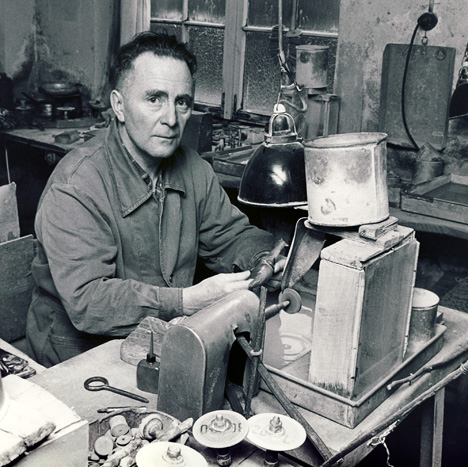
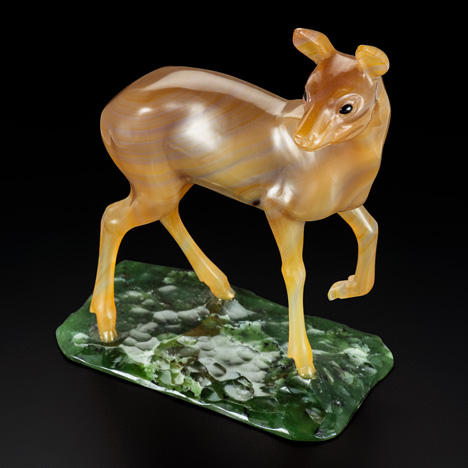
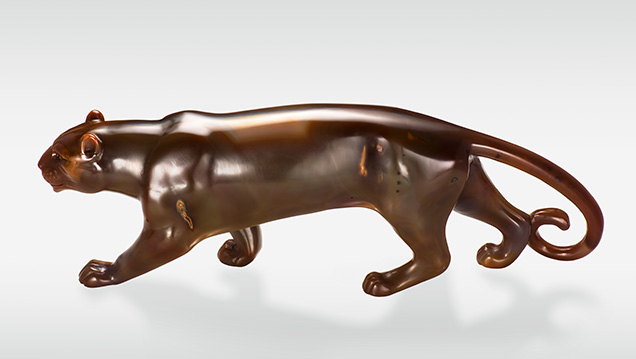
Aside from his large, single-stone carvings, Paul Dreher also experimented with combinations of several carved gem materials in composite sculptures. These animal figures became very popular and were of such exceptional quality that they were sometimes misidentified as Fabergé pieces. According to Gerd Dreher (2012), “We were rather surprised to see two original carvings made by my father in the second edition (1962) of the book The Art of Carl Fabergé by A. Kenneth Snowman.” The mistake is somewhat understandable: Unsigned pieces by the Drehers, and others in Idar-Oberstein, continued to be sold through brokers or dealers. The style once inspired by Fabergé had endured for decades, long after the legendary company had ceased to exist.
Why did the pieces go unsigned? The brokers had the luxury of travel and fluency in languages used in international commerce. They often presented the pieces as a shared Idar-Oberstein quality brand. Based in Idar-Oberstein and abroad, these brokers sold the carvings internationally or in some cases passed them along as examples of their own work (P. Dreher, pers. comm., 2017). This was considered normal business practice. There were positive and negative effects of this business model. On one hand, carving families in Idar-Oberstein did not have to concern themselves with marketing and sales. They could concentrate on producing the work and take the time to develop new skills. The obvious drawbacks, however, were that the carvers did not receive recognition, build a reputation, or understand their own market. This business arrangement lasted well into the career of Gerd Dreher. The unfortunate result was that the Dreher name was not widely recognized outside of Idar-Oberstein.
Gerd Dreher, born in 1939, was trained by his father starting at the age of 16, in the time-honored local tradition of passing these skills from father to son (see “Idar-Oberstein’s Gem Industry” section above). Between the 1960s and 1980s, Gerd followed a path similar to that of his father, carving various gem materials, often in ways that could be composited to create animal figures such as the one in figure 14.
![Gerd Dreher’s “Love Birds”] Gerd Dreher’s “Love Birds”]](https://www.gia.edu/images/WN17-Weldon-Fig_14_226172_468px.jpg)
After Gerd Dreher took over the family business, he realized the need to change how his carvings were brought to market. He finally began to sign Dreher animal carvings in the 1970s, and collectors quickly seized upon the crisp logo they saw etched along the edges of the artwork. Dreher carvings began to emerge from relative obscurity.
He observed that his artwork would benefit from carving single pieces of gem material—demonstrating what can be done with a single gem—albeit with accents, or an occasional quartz base to help a carving stand upright. Accents include gold fins for fish, feathered crests for birds, and tails for various animals. These accents are carved in wax and then cast in gold. Eyes are also added features, and they are sufficiently unique as to require particular attention. They are made from small translucent to opaque sections of agate, or black agates cut as cabochons. The translucent areas are lined internally with gold leaf. This results in the shimmering appearance seen in an amphibian’s eye (figure 15) or the brilliant, dark stare of a mouse. Both appear startlingly similar to real eyes.
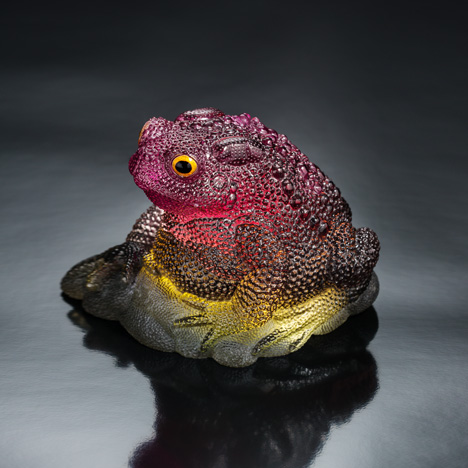
By 1980, much finer diamond-sintered tools became available. “It allowed us to carve mammals, reptiles, and amphibious creatures with much finer detail than before,” Patrick Dreher recalls. These tools could also cut faster. But as Gerd Dreher cautioned his son, who was an apprentice by then, “The tools are not meant for us to produce faster. We will only use them to produce better.” Elaborate carving techniques they continue to master show refined, individual detail in fur, where even single strands can be identified (see box A). Varying degrees of carving depth create selected areas of translucency or opacity, which often evoke comparisons with actual animals. Ears on a mouse or rabbit are strikingly thin and translucent, yet they still exhibit the detailed dimples and folds seen in a live animal. Advancements in the quality of the tools, merged with a deep understanding of the subject’s appearance, imbue the creatures with stunning personalities (figures 16 and 17). Art critic Galina Gabriel considers the present generation of Drehers consummate masters, and Gerd specifically the “world’s most prestigious gemstone carver” (Gabriel, 2015; Gabriel, 2017).
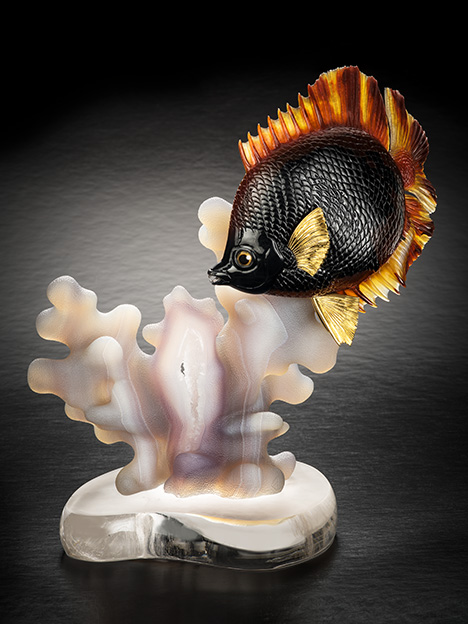
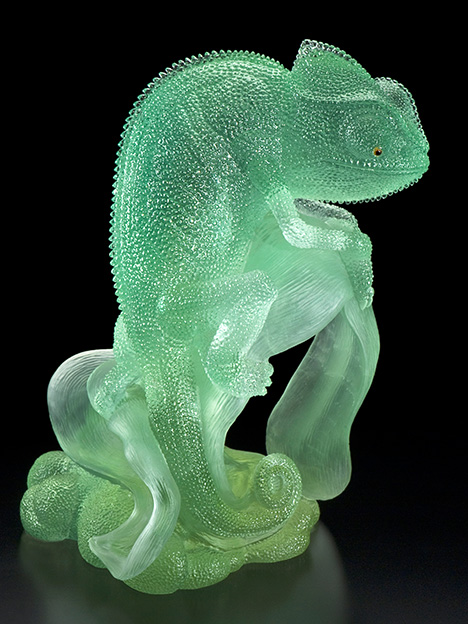
THE DREHER PHILOSOPHY
Neatly categorized shoeboxes line the walls of the tiny Dreher studio, packed with photographs and sketches of fauna in various poses. Some are copied from books or magazines for reference. The photographs also feature animals that are live-captured by the Drehers to act as models for the carvers. It is the Drehers’ impressive collection of images and sketches that gives the family a depth of understanding about their subjects that few other carvers enjoy. Patrick Dreher recalls that on one occasion he was looking for a “preening” mouse. He could not photograph the desired pose in a captured mouse until a tiny bit of strawberry jam was strategically smeared on a small patch of the mouse’s fur. It had the intended effect: The mouse soon went to work cleaning himself. The photographs, which are taken from multiple angles, help the Drehers interpret and incorporate three dimensions into the finished object. These live animals fulfill their role as models, resulting in carvings such as the startled mouse (figure 18). After that, they are carefully released back into the wild, unaware that their likenesses are sought by collectors around the world.
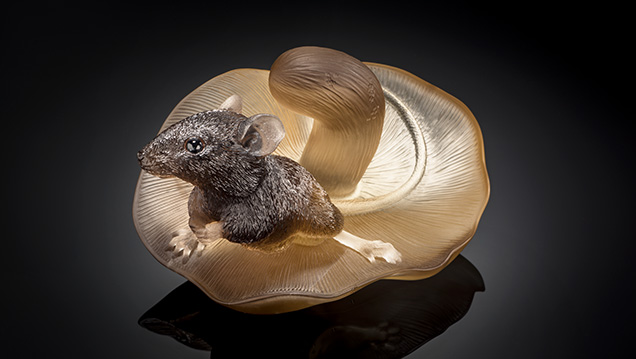
The Drehers carve a variety of rough gem material ranging from 5 to 9 on the Mohs hardness scale, though their stated preference is always agate. They appreciate agate’s toughness but also its wide-ranging color variations, which guarantee distinctive works of art. Carving into the layers of color zoning in agate provides the “canvas” and opportunity for three-dimensionality. Dreher carvings also appear regularly in rock crystal quartz, ruby-in-zoisite, beryl, topaz, rhodonite, obsidian, and tourmaline, among other gem materials. Here, too, the Drehers use color zoning in single crystals to their advantage, or to reveal a story in the carving.
Collectors generally supply the raw material in crystal form or as rough chunks. It is always valuable and often extremely rare. One notable example is a toad (figure 19) carved from a single piece of Brazilian tourmaline crystal provided by California gem mineral collector William Larson.
“This piece came to us in colors of black, red, green, and black again,” Patrick Dreher recalls. “As we began to remove the black material, we saw a thin layer of blue we hadn’t seen before. This increased the value and became the head of the toad. The pink and red colors that emerged became the body of the toad, and the green color became the feet. This ‘Queen of the Toads’ is the most valuable piece we have ever carved.”
Patrick, born in 1970, apprenticed with his father, in keeping with the family’s tradition. “My father is the best teacher I could possibly get,” he says. Both work together at their home-based studio. “It’s not like a traditional job where you go home after work. I’m home already. And my boss is also my father!” Patrick explains that he was exposed to the craft as a toddler, with ample opportunities to absorb his father’s carving methods. Actual hands-on work began by the age of 18. In 1997, Gerd and Patrick traveled to Rio Grande do Sul, Brazil’s southernmost state, and brought back 3.5 tons of handpicked agate rough, which they continue to work with to this day.
The 1980s and ’90s also provided incredible new gemstone finds, such as large beryl crystals from Ukraine that were available after the fall of the Soviet Union. Gem materials were also emerging from Brazil and from newer sources such as Afghanistan, East Africa, and Madagascar. This gemstone windfall dovetailed nicely into the family’s growth, with two decades of some of the finest, largest, single-crystal gem materials that had been found in the twentieth century. A young bird’s nest lavishly carved from an enormous hexagonal Ukrainian green heliodor (figure 20) exemplifies the era. Sensitive to the beauty of the geometric etched pits on the crystal, Gerd Dreher left one face of the beryl intact with the gem’s natural surface. Similarly, a mouse carved from African ruby and zoisite (figure 21) illustrates the massive ornamental materials beginning to emerge from Africa at the time.
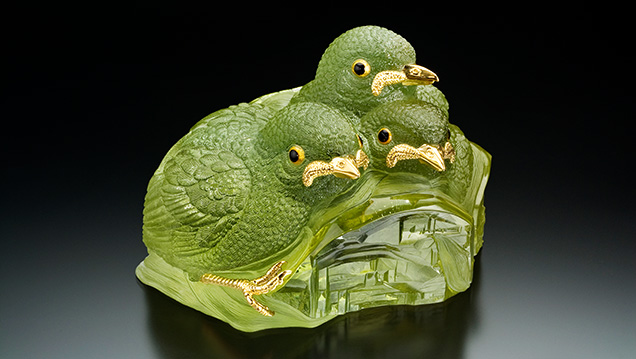
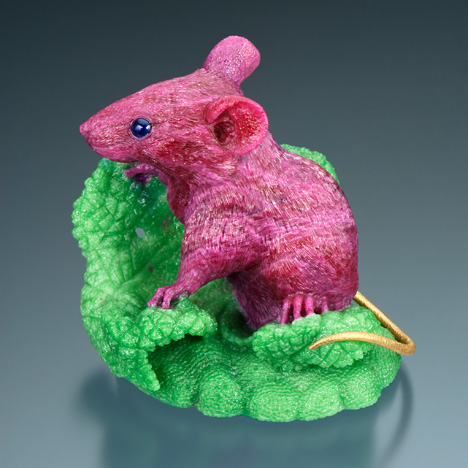
Patrick says that he and his father consistently carve 12–20 new works every year, each of which may take 300–400 hours to complete. Father and son work both independently and collaboratively on pieces and continue to find new collectors to supply them with exceptional gem material.
Patrick’s own mastery of the craft was realized in a dramatic fashion when, after decades of apprenticeship, he detailed a plan to carve a rounded but completely smooth and glassy hippopotamus out of citrine quartz. “It cannot and should not be done—you’ll be wasting material,” his father chided. Nevertheless, Patrick was steadfast in his resolve, and his father ultimately agreed the piece was masterful (figure 22).
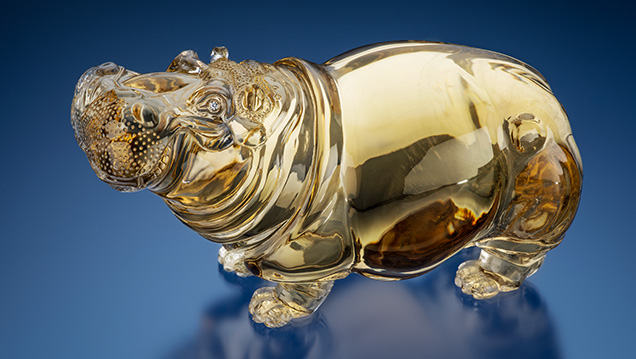
Patrick has since carved a number of important pieces, including a starfish from a strawberry quartz specimen that in its rough state had concealed a secret. It was not until he began the removal of unwanted or damaged sections that the strawberry quartz revealed pale amethyst and colorless rock crystal quartz in the layers beneath. The color variations in the amethyst became a coral reef on an ocean floor of rock crystal (figure 23).
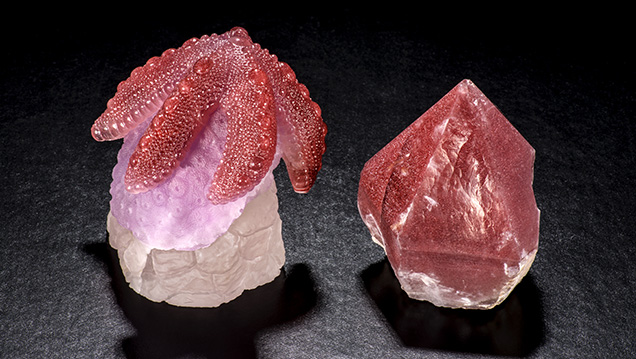
Inside their home studio, the Drehers take turns at the spindle. A collection of diamond-sintered tools, in different sizes and numbering in the hundreds, await their turn at the workstation. These tools, and the skilled use of them, bring out extremely fine detail. With a few exceptions, it is this detail that defines the present era. In his day, Paul Dreher carved unique large items like the puma and deer, in which the personality came to life in the carvings’ well-defined but smooth, soft surfaces, reflecting a mastery that was limited only by his tools. Today’s carvings have generally lost that smoothness in favor of extraordinary detail, attention to realism, and quality (see box B).
CONCLUSIONS
For centuries, the German towns of Idar and Oberstein have been known for agate cutting. Joined as one town before World War II, the region developed into a cutting and carving center for colored gemstones. Two of its principal carvers, Gerd and Patrick Dreher, can trace their family’s association with agate back thirteen generations, with the last five involved in three-dimensional gem carving. Father and son (figure 24) are considered by many to be the world’s greatest living gem carvers, and their work continues to be acquired by collectors around the world.
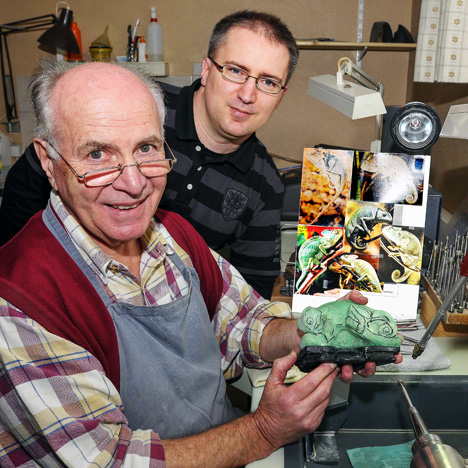
FOOTNOTE
1Netsuke refers to a toggle or button adorned with a miniature carving, often depicting animals, made from ivory, wood, lacquer, bone, or metal.



.jpg)


